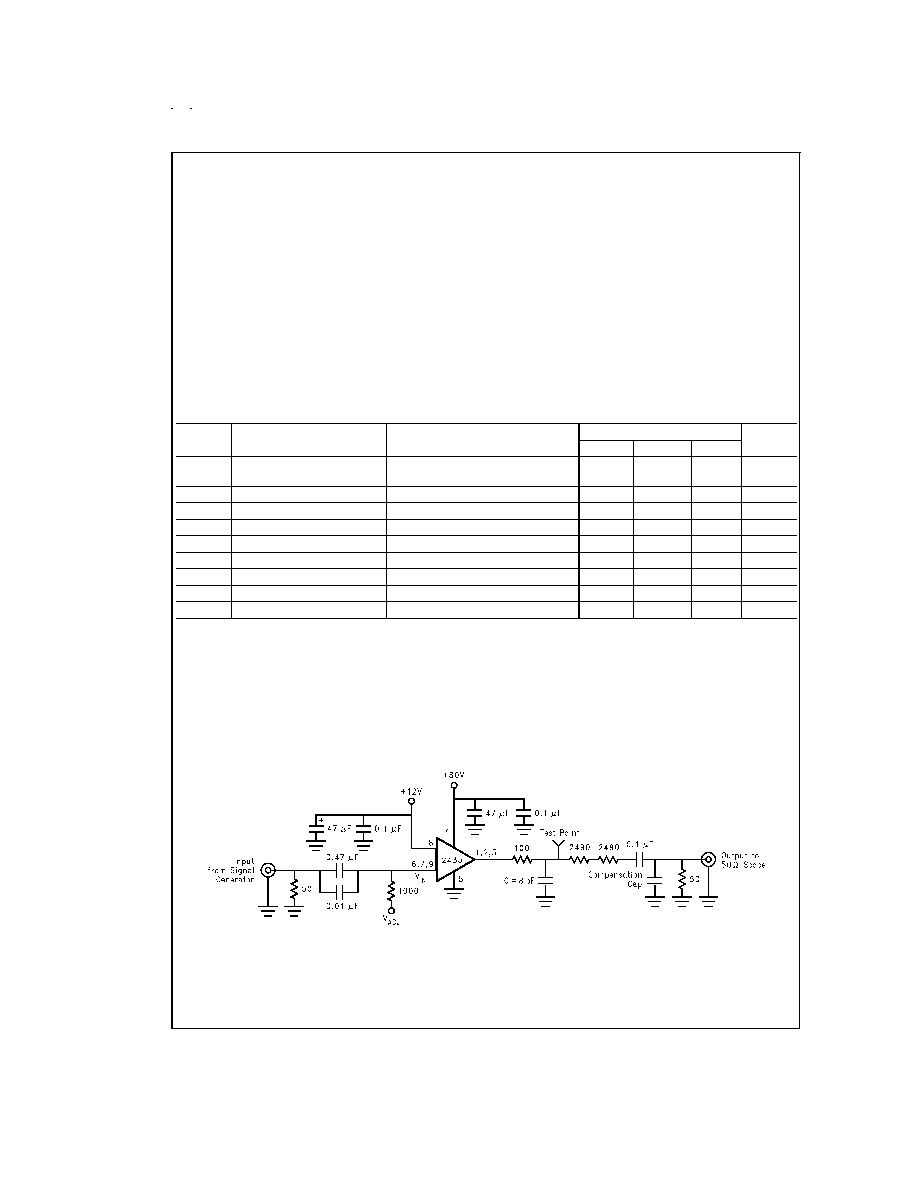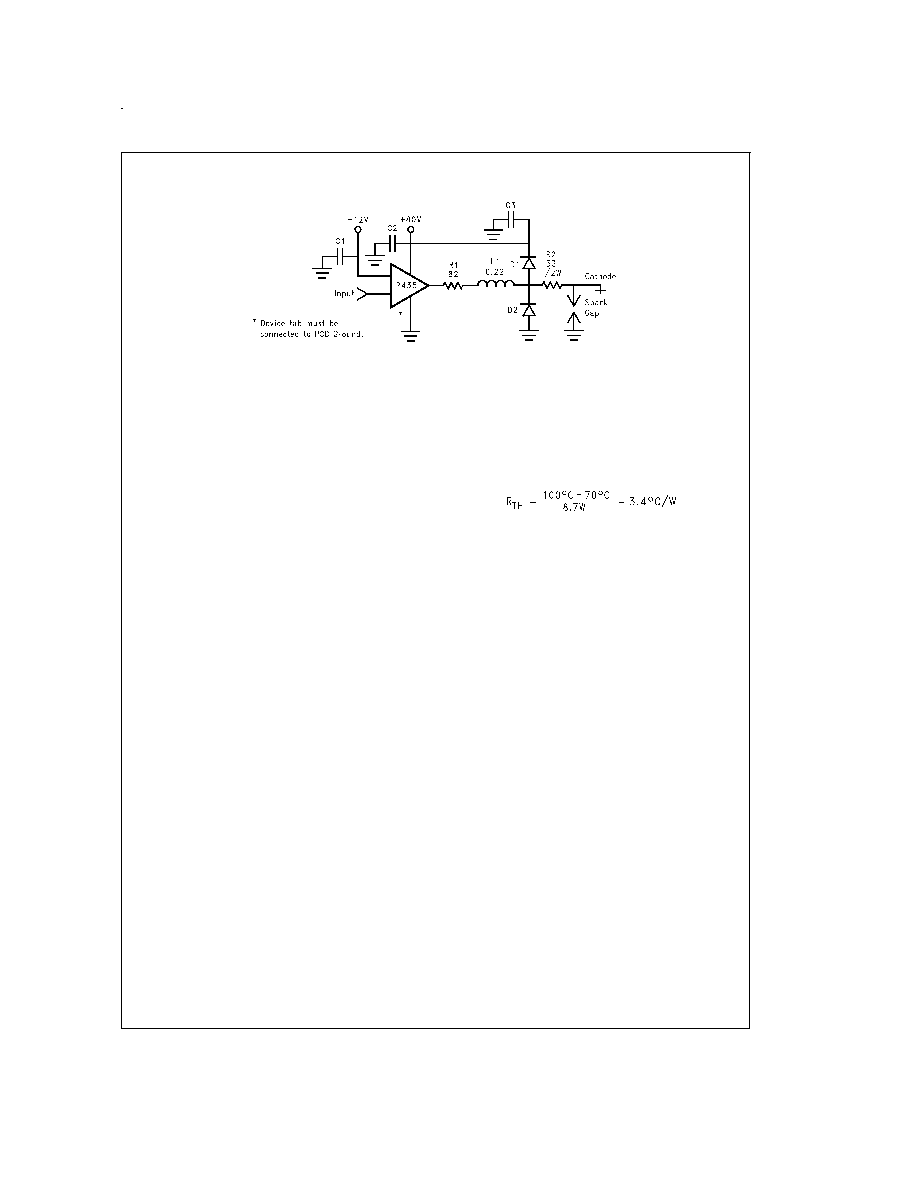
LM2435
Monolithic Triple 5.5 ns CRT Driver
General Description
The LM2435 is an integrated high voltage CRT driver circuit
designed for use in color monitor applications. The IC con-
tains three high input impedance, wide band amplifiers
which directly drive the RGB cathodes of a CRT. Each chan-
nel has its gain internally set to -14 and can drive CRT ca-
pacitive loads as well as resistive loads present in other ap-
plications, limited only by the package's power dissipation.
The IC is packaged in an industry standard 9-lead TO-220
molded plastic power package. See Thermal Considerations
section.
Features
n
Dissipates approximately 45% less power than the
LM2405
n
Well matched with LM1279 and LM1282/83 video
preamps
n
0V to 5V input range
n
Stable with 0 pF20 pF capacitive loads and inductive
peaking networks
n
Convenient TO-220 staggered lead package style
n
Standard LM243X Family Pinout which is designed for
easy PCB layout
Applications
n
1280 x 1024 Displays up to 75 Hz Refresh
n
Pixel clock frequencies up to 135 MHz
n
Monitors using video blanking
Schematic and Connection Diagrams
DS101044-1
FIGURE 1. Simplified Schematic Diagram
(One Channel)
DS101044-2
Note: Tab is at GND
Top View
Order Number LM2435T
August 1999
LM2435
Monolithic
T
riple
5.5
ns
CRT
Driver
© 1999 National Semiconductor Corporation
DS101044
www.national.com

Absolute Maximum Ratings
(Notes 1, 3)
If Military/Aerospace specified devices are required,
please contact the National Semiconductor Sales Office/
Distributors for availability and specifications.
Supply Voltage, (V
CC
)
+90V
Bias Voltage, (V
BB
)
+16V
Input Voltage, (V
IN
)
0V to 6V
Storage Temperature Range, (T
STG
)
-65°C to +150°C
Lead Temperature
(Soldering,
<
10 sec.)
300°C
ESD Tolerance, Human Body Model
2 kV
Machine Model
250V
Operating Ranges
(Note 2)
V
CC
+60V to +85V
V
BB
+8V to +15V
V
IN
+0V to +5V
V
OUT
+15V to +75V
Case Temperature
-20°C to +100°C
Do not operate the part without a heat sink.
Electrical Characteristics
(See
Figure 2 for Test Circuit)
Unless otherwise noted: V
CC
= +80V, V
BB
= +12V, C
L
= 8 pF, T
C
= 50°C
DC Tests: V
IN
= +2.8 V
DC
AC Tests: Output = 40 V
PP
(25V to 65V) at 1 MHz.
Symbol
Parameter
Condition
LM2435
Units
Min
Typ
Max
I
CC
Supply Current
Per Channel, No Input Signal, No
Output Load
13
mA
I
BB
Bias Current
All Three Channels
14
mA
V
OUT
DC Output Voltage
No AC Input Signal, V
IN
= 1.35V
62
65
68
V
DC
A
V
DC Voltage Gain
No AC Input Signal
-12
-14
-16
A
V
Gain Matching
(Note 4), No AC Input Signal
1.0
dB
LE
Linearity Error
(Notes 4, 5), No AC Input Signal
8
%
t
R
Rise Time
(Note 6), 10% to 90%
5.5
ns
t
F
Fall Time
(Note 6), 90% to 10%
6.0
ns
OS
Overshoot
(Note 6)
5
%
Note 1: Absolute Maximum Ratings indicate limits beyond which damage to the device may occur.
Note 2: Operating ratings indicate conditions for which the device is functional, but do not guarantee specific performance limits. For guaranteed specifications and
test conditions, see the Electrical Characteristics. The guaranteed specifications apply only for the test conditions listed. Some performance characteristics may
change when the device is not operated under the listed test conditions.
Note 3: All voltages are measured with respect to GND, unless otherwise specified.
Note 4: Calculated value from Voltage Gain test on each channel.
Note 5: Linearity Error is the variation in dc gain from V
IN
= 1.0V to V
IN
= 4.5V.
Note 6: Input from signal generator: t
r
, t
f
<
1 ns.
AC Test Circuit
Figure 2 shows a typical test circuit for evaluation of the LM2435. This circuit is designed to allow testing of the LM2435 in a 50
environment without the use of an expensive FET probe. The two 2490
resistors at the output form a 200:1 voltage divider when
connected to a 50
load. The compensation cap is used to flatten the frequency response of the 200:1 divider.
DS101044-3
Note: 8 pF load includes parasitic capacitance.
FIGURE 2. Test Circuit (One Channel)
www.national.com
2

Typical Performance Characteristics
(V
CC
= +80 V
DC
, V
BB
= +12 V
DC
, C
L
= 8 pF, V
OUT
= 40V
PP
(25V-65V), Test Circuit -
Figure 2 unless otherwise specified)
DS101044-4
FIGURE 3. V
OUT
vs V
IN
DS101044-5
FIGURE 4. Speed vs Temperature
DS101044-6
FIGURE 5. LM2435 Pulse Response
DS101044-7
FIGURE 6. Power Dissipation vs Frequency
DS101044-8
FIGURE 7. Speed vs Offset
DS101044-9
FIGURE 8. Speed vs Load Capacitance
www.national.com
3

Theory of Operation
The LM2435 is a high voltage monolithic three channel CRT
driver suitable for high resolution display applications. The
LM2435 operates with 80V and 12V power supplies. The
part is housed in the industry standard 9-lead TO-220
molded plastic power package.
The circuit diagram of the LM2435 is shown in
Figure 1. The
PNP emitter follower, Q5, provides input buffering. Q1 and
Q2 form a fixed gain cascode amplifier with resistors R1 and
R2 setting the gain at -14. Emitter followers Q3 and Q4 iso-
late the high output impedance of the cascode stage from
the capacitance of the CRT cathode which decreases the
sensitivity of the device to load capacitance. Q6 provides bi-
asing to the output emitter follower stage to reduce cross-
over distortion at low signal levels.
Figure 2 shows a typical test circuit for evaluation of the
LM2435. This circuit is designed to allow testing of the
LM2435 in a 50
environment without the use of an expen-
sive FET probe. In this test circuit, two low inductance resis-
tors in series totaling 4.98 k
form a 200:1 wideband, low
capacitance probe when connected to a 50
coaxial cable
and a 50
load (such as a 50
oscilloscope input). The in-
put signal from the generator is ac coupled to the base of
Q5.
Application Hints
INTRODUCTION
National Semiconductor (NSC) is committed to provide ap-
plication information that assists our customers in obtaining
the best performance possible from our products. The follow-
ing information is provided in order to support this commit-
ment. The reader should be aware that the optimization of
performance was done using a specific printed circuit board
designed at NSC. Variations in performance can be realized
due to physical changes in the printed circuit board and the
application. Therefore, the designer should know that com-
ponent value changes may be required in order to optimize
performance in a given application. The values shown in this
document can be used as a starting point for evaluation pur-
poses. When working with high bandwidth circuits, good lay-
out practices are also critical to achieving maximum perfor-
mance.
IMPORTANT INFORMATION
The LM2435 performance is targeted for the SXGA (1280 x
1024, 75 Hz refresh) resolution market. The application cir-
cuits shown in this document to optimize performance and to
protect against damage from CRT arc-over are designed
specifically for the LM2435. If another member of the
LM243X family is used, please refer to its datasheet. Since
the LM2435 is a high speed amplifier, the connection of the
device to PCB ground is very important. It is critical that the
device tab is connected to PCB Ground through the heat-
sink, in order to eliminate excessive overshoot and ringing.
The LM1279/243X (Rev. B) demo board provides a good ex-
ample of how to do this.
POWER SUPPLY BYPASS
Since the LM2435 is a wide bandwidth amplifier, proper
power supply bypassing is critical for optimum performance.
Improper power supply bypassing can result in large over-
shoot, ringing or oscillation. A 0.1 µF capacitor should be
connected from the supply pin, V
CC
, to ground, as close to
the supply and ground pins as is practical. Additionally, a
10 µF to 100 µF electrolytic capacitor should be connected
from the supply pin to ground. The electrolytic capacitor
should also be placed reasonably close to the LM2435's
supply and ground pins. A 0.1 µF capacitor should be con-
nected from the bias pin, V
BB
, to ground, as close as is prac-
tical to the part.
ARC PROTECTION
During normal CRT operation, internal arcing may occasion-
ally occur. Spark gaps, in the range of 200V, connected from
the CRT cathodes to CRT ground will limit the maximum volt-
age, but to a value that is much higher than allowable on the
LM2435. This fast, high voltage, high energy pulse can dam-
age the LM2435 output stage. The application circuit shown
in
Figure 9 is designed to help clamp the voltage at the out-
put of the LM2435 to a safe level. The clamp diodes, D1 and
D2, should have a fast transient response, high peak current
rating, low series impedance and low shunt capacitance.
FDH400 or equivalent diodes are recommended. Do not use
1N4148 diodes for the clamp diodes. D1 and D2 should have
short, low impedance connections to V
CC
and ground re-
spectively. The cathode of D1 should be located very close
to a separately decoupled bypass capacitor (C3 in
Figure 9).
The ground connection of D2 and the decoupling capacitor
should be very close to the LM2435 ground. This will signifi-
cantly reduce the high frequency voltage transients that the
LM2435 would be subjected to during an arcover condition.
Resistor R2 limits the arcover current that is seen by the di-
odes while R1 limits the current into the LM2435 as well as
the voltage stress at the outputs of the device. R2 should be
a 1/2W solid carbon type resistor. R1 can be a 1/4W metal or
carbon film type resistor. Having large value resistors for R1
and R2 would be desirable, but this has the effect of increas-
ing rise and fall times. Inductor L1 is critical to reduce the ini-
tial high frequency voltage levels that the LM2435 would be
subjected to. The inductor will not only help protect the de-
vice but it will also help minimize rise and fall times as well as
minimize EMI. For proper arc protection, it is important to not
omit any of the arc protection components shown in
Figure
9.
www.national.com
4

Application Hints
(Continued)
OPTIMIZING TRANSIENT RESPONSE
Referring to
Figure 9, there are three components (R1, R2
and L1) that can be adjusted to optimize the transient re-
sponse of the application circuit. Increasing the values of R1
and R2 will slow the circuit down while decreasing over-
shoot. Increasing the value of L1 will speed up the circuit as
well as increase overshoot. It is very important to use induc-
tors with very high self-resonant frequencies, preferably
above 300 MHz. Ferrite core inductors from J.W. Miller Mag-
netics (part # 78FR22K) were used for optimizing the perfor-
mance of the device in the NSC application board. The val-
ues shown in
Figure 9 can be used as a good starting point
for the evaluation of the LM2435. Using a variable resistor
for R1 will simplify finding the value needed for optimum per-
formance in a given application. Once the optimum values
are determined the variable resistor can be replaced with
fixed values.
EFFECT OF LOAD CAPACITANCE
Figure 8 shows the effect of increased load capacitance on
the speed of the device. This demonstrates the importance
of knowing the load capacitance in the application.
EFFECT OF OFFSET
Figure 7 shows the variation in rise and fall times when the
output offset of the device is varied from 40 V
DC
to 50 V
DC
.
The rise time shows a maximum variation relative to the cen-
ter data point (45 V
DC
) of about 13%. The fall time shows a
maximum variation of about 3% relative to the center data
point.
THERMAL CONSIDERATIONS
Figure 4 shows the performance of the LM2435 in the test
circuit shown in
Figure 2 as a function of case temperature.
The figure shows that the rise time of the LM2435 increases
by approximately 12% as the case temperature increases
from 50°C to 100°C. This corresponds to a speed degrada-
tion of 2.4% for every 10°C rise in case temperature. There
is a negligible change in fall time vs. temperature in the test
circuit.
Figure 6 shows the maximum power dissipation of the
LM2435 vs Frequency when all three channels of the device
are driving an 8 pF load with a 40 V
p-p
alternating one pixel
on, one pixel off signal. The graph assumes a 72% active
time (device operating at the specified frequency) which is
typical in a monitor application. The other 28% of the time
the device is assumed to be sitting at the black level (65V in
this case). This graph gives the designer the information
needed to determine the heat sink requirement for the appli-
cation. The designer should note that if the load capacitance
is increased the AC component of the total power dissipation
will also increase.
The LM2435 case temperature must be maintained below
100°C. If the maximum expected ambient temperature is
70°C and the maximum power dissipation is 8.7W (from
Fig-
ure 6, 72.5 MHz bandwidth) then a maximum heat sink ther-
mal resistance can be calculated:
This example assumes a capacitive load of 8 pF and no re-
sistive load.
TYPICAL APPLICATION
A typical application of the LM2435 is shown in
Figure 10.
Used in conjunction with an LM1279, a complete video chan-
nel from monitor input to CRT cathode can be achieved. Per-
formance is ideal for 1280 x 1024 resolution displays with
pixel clock frequencies up to 135 MHz.
Figure 10 is the sche-
matic for the NSC demonstration board that can be used to
evaluate the LM1279/2435 combination in a monitor.
PC BOARD LAYOUT CONSIDERATIONS
For optimum performance, an adequate ground plane, isola-
tion between channels, good supply bypassing and minimiz-
ing unwanted feedback are necessary. Also, the length of the
signal traces from the preamplifier to the LM2435 and from
the LM2435 to the CRT cathode should be as short as pos-
sible. The following references are recommended:
Ott, Henry W., "Noise Reduction Techniques in Electronic
Systems", John Wiley & Sons, New York, 1976.
"Video Amplifier Design for Computer Monitors", National
Semiconductor Application Note 1013.
Pease,
Robert A.,
"Troubleshooting Analog
Circuits",
Butterworth-Heinemann, 1991.
Because of its high small signal bandwidth, the part may os-
cillate in a monitor if feedback occurs around the video chan-
nel through the chassis wiring. To prevent this, leads to the
video amplifier input circuit should be shielded, and input cir-
cuit wiring should be spaced as far as possible from output
circuit wiring.
It is very important that the tab of the heatsink is connected
to PCB ground. The single ground pin does not provide an
adequate return path at high frequencies. The ground con-
nection can be made using the heatsink. The NSC LM1279
& LM243X (Nov. 1998, Rev. B) demo board, shown in
Figure
11 and Figure 12, provides a good example of how this can
be done. A Thermalloy 6698B heatsink is used in the demo
DS101044-10
FIGURE 9. One Channel of the LM2435 with the Recommended Application Circuit
www.national.com
5




